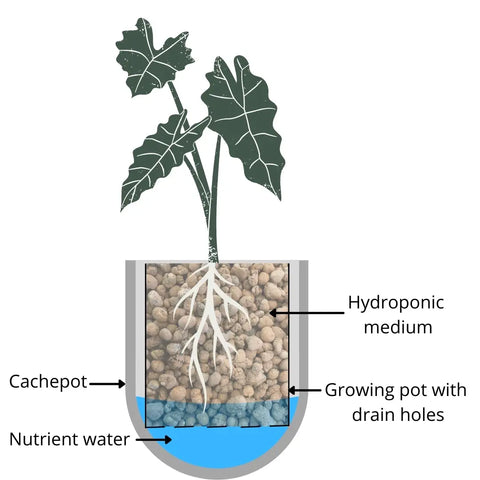Call, text, or email us -
0432883965
info@greenmyspace.com.au

Many houseplant collectors are turning their attention to growing their plants in water, or hydroponically, for a variety of reasons. Perhaps the most appealing reason is that it takes the guessing out of watering. The main killer of house plants is over and under watering, and both issues can be alleviated with hydroponics. Plants grown hydroponically are also less prone to pests (including fungas gnats), and in our opinion are easier to care for.
Passive (or Semi) Hydroponics
Passive hydroponics is the easiest and cheapest form of hydroponics, making it easy to display your plants at home while growing them hydroponically. Unlike active hydro, it eliminates the need for electricity and complicated, often expensive, set-ups. Active hydroponics involves moving the water that the plant is growing in with the use of an electric pump, thereby keeping the water oxygenated. When water is stagnate (or still), it becomes oxygen depleted, which can limit the growth and hinder the health of your plant. There are some simple methods you can utilise at home to mitigate this problem when growing in passive hydro.
How to grow your houseplants in passive Hydroponics
Firstly, lets talk about growing mediums. Its best to use an inorganic hydropic medium as opposed to just growing in nothing but water, because it’ll give your plant’s roots something to grab onto, and helps keep the plant stable and upright. Hydroponic mediums wick water up from the reservoir to the plant’s roots, meaning that you don’t need to completely submerge your plants roots in water for them to get the moisture they need. This is important because it’ll allow more oxygen to get to the roots.
The most commonly used hydroponic mediums for houseplants are leca (or aggregated clay balls), Dr Greenthumbs MAB grow, Lechuza PON, and perlite. You should ‘plant’ your plant in a hydroponic medium, just as you would if you were planting it in soil. The pot you use needs to have drain holes. You can then sit this pot inside a cachepot (decorative pot without drain holes) and add enough water to the base of the cachepot so that approximately 2 - 3 cm of the hydroponic medium is submerged in water. You also need to add a plant nutrient to the water, which along with light, will give your plant everything it needs to thrive. It’s important to keep the pH (acidity level) of the water between 5.5 – 6.5, as this will optimise the plant’s nutrient uptake. 
The water’s pH level can be monitored and altered using a basic pH kit. In most cases, using a pH buffered nutrient will alleviate the need to adjust pH, however it will depend on the water in your area. Here in the northern suburbs of metropolitan Melbourne, I can just add my pH buffered nutrient (I use Growth Technology Foliage Focus dilutes to 5ml per litre of water), and my pH is always within the optimum range.
How to prepare a plant for Hydroponics
When preparing a plant for hydroponics, it is absolutely vital that you remove ALL soil from the plants roots. You can do this by first using your hands to remove as much soil as possible, then sit the roots in warm water for a few minutes to loosen the remaining soil. You can then go ahead and rinse off the remaining soil under a high-pressure hose or tap. It can be hard to remove all the soil from fine rooted plants, and in this case, I believe it’s best to cut off any roots that are heavily coated in soil. Putting roots that are coated with soil into passive hydroponics will lead to root rot and ultimately the death of your plant.
Once all the soil is removed from your plant’s roots, you can then go ahead and select a hydroponics medium to pot it into. This is really personal preference, everyone has their own ideas about what works best. I personally prefer leca for think-rooted plants like mature anthuriums and monstera. Dr Green Thumbs MAB grow works wonderfully for syngoniums and plants with finer roots, and young seedlings seem to love the moisture provided by perlite. Lechuza PON is very similar to MAB grow, but it is pH buffered and also contains fertiliser, so there is no need to add nutrients to the water when using PON (although the nutrients will slowly deplete and after 12 months of use you should either add nutrients to your water or the substrate).
The brand of nutrient you add to the water is also personal preference, but Growth Technology is a clear leader for the indoor plant market. GT Foliage Focus is perfect for all indoor plants, but if you’d like to see your plant’s flower then you should opt for GT Complete Focus. The GT range of nutrients are pH buffered.
Maintaining your plant’s that are growing in passive hydroponics
Growing your plants in hydroponics makes their care so much easier, and also allows you to go on holidays without the worry of your plant’s dying of thirst. However, there are a few things that you need to add to your plant routine once you’ve made the move to hydroponics.

